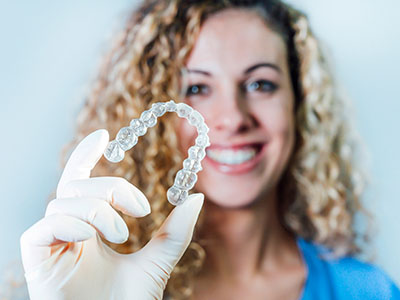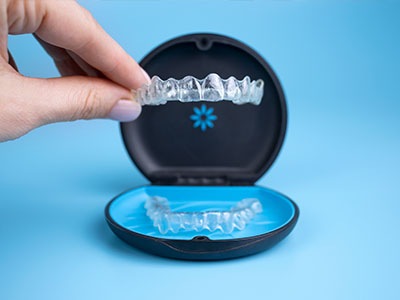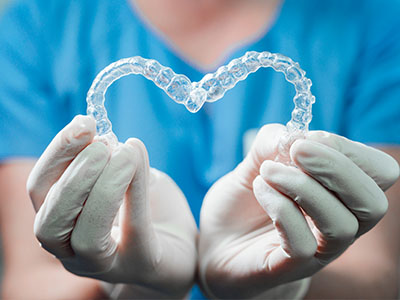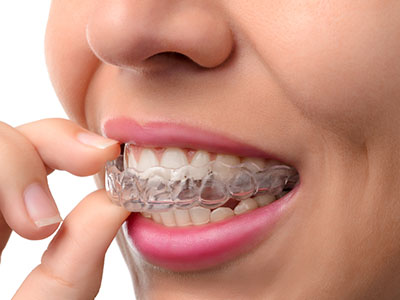
Invisalign® has changed the expectation for orthodontic care by offering a discreet, technology-driven alternative to traditional braces. Rather than brackets and wires, treatment relies on a planned sequence of clear, removable aligners that guide teeth into healthier, more functional positions. This approach lets many people blend treatment into their lives with minimal disruption while still achieving precise, clinically supervised results. At Cherokee Smiles Dental, we combine clinical judgment with proven aligner technology to help patients meet their alignment goals confidently and comfortably.

Invisalign® for Teens

Invisalign® for Brides

Invisalign® for Travelers

Before & After Photos

Invisalign® Videos

FAQs

Invisalign® vs Braces

Invisalign® vs Direct-To-Consumer Aligners

Is Invisalign® Right For Me?

Invisalign® Costs
Clear-aligner systems like Invisalign® are engineered around a different philosophy than fixed appliances. Instead of applying continuous forces from brackets and wires, aligners deliver a series of incremental, planned movements through successive plastic trays. Each tray is designed to make a small adjustment — a fraction of a millimeter — so that over time the cumulative effect is predictable and controlled. That staged progression is one reason clinicians value aligner therapy for its precision and patient-friendly features.
The removable nature of aligners is a practical advantage for many adults and teens. Because trays can be taken out for eating and hygiene tasks, patients maintain more straightforward oral care throughout treatment. This can reduce the risk of plaque buildup and allow people to keep their regular diets for the most part, with only brief adjustments to aligner wear routines. The ability to remove trays also makes social and professional situations easier for those who prefer a less visible approach to orthodontics.
Nonetheless, aligner therapy is clinical treatment — not an over-the-counter solution. Effective results depend on accurate diagnostics, thoughtful planning, and periodic professional oversight. Modern systems pair digital scanning, 3-D modeling, and treatment simulation to shape a sequence of aligners tailored to an individual’s anatomy and goals. Working with a dental professional ensures the plan addresses bite, function, and long-term stability, rather than focusing solely on surface appearance.
Successful alignment begins with a comprehensive clinical evaluation. A dentist or orthodontist will assess tooth positions, bite relationships, gum health, and any restorative work that may influence movement. Many practices now use a high-resolution intraoral scanner to capture a precise digital model of the mouth, eliminating the need for traditional impression material. That digital record becomes the foundation for a customized plan that maps sequential tooth movements from the starting position to the desired outcome.
Using advanced 3-D software, clinicians can visualize each step of the treatment and predict how teeth will respond. This lets the provider design attachments (small tooth-colored features bonded to certain teeth), specify rotation or tipping movements, and time adjustments so that complex changes happen in a controlled sequence. Patients often receive a simulated “preview” of projected results, which helps set realistic expectations and provides a reference for progress during care.
The aligner trays themselves are manufactured to precise tolerances based on the final plan. Each tray is slightly different, exerting targeted pressure at specific points to encourage the intended movement. As the patient swaps trays according to the schedule provided by the clinician, the mouth advances through the planned stages. Regular follow-up appointments allow the provider to monitor response, make refinements if needed, and ensure that tooth movement is proceeding safely and predictably.
Although technology plays a central role, treatment remains a blend of science and clinical experience. The best outcomes come from careful diagnosis, thoughtful treatment sequencing, and a partnership between the patient and their dental team throughout the process.
The cadence of aligner treatment is straightforward but requires patient commitment. Most clinicians ask patients to wear their trays for the majority of each day, removing them only for short periods to eat, brush, and floss. Adhering to the recommended daily wear time is one of the most important factors in keeping the schedule on track and obtaining predictable movement. During the first few days with a new tray, you may feel mild pressure — a normal sign that the aligner is engaging the teeth.
Routine check-ins are scheduled to verify progress and make any necessary adjustments. These visits let your clinician confirm that the teeth are tracking according to plan and address issues such as fit or comfort. If refinements are needed, additional trays or a revised treatment sequence can be developed with minimal disruption. Because each step is planned, incremental changes generally translate into steady improvement without dramatic, sudden shifts.
Oral hygiene is more straightforward with removable trays, but it still requires diligence. Brushing and flossing after meals before reinserting aligners helps protect enamel and soft tissues. If attachments are part of your plan, they will be small and discreet; they play an important role in achieving certain movements and are designed to be as unobtrusive as possible. Over time, patients often report increased confidence as their smile evolves according to the treatment projection.
One of the appeal points of clear aligners is their compatibility with normal routines. Because trays can be removed, many people find it easier to enjoy meals and maintain social habits. However, consistency matters: unreliable wear patterns can slow or negate progress. Clinicians emphasize simple habits — set reminders, carry a storage case, and maintain a nightly cleaning routine — that make adherence straightforward and sustainable over the course of treatment.
Cleaning trays is simple and essential. Gentle brushing and rinsing, along with periodic soaking in a recommended cleanser, keeps aligners clear and sanitary. Avoid hot water or harsh cleaners that could warp the plastic. Maintaining regular dental cleanings and exams throughout treatment also protects gum and tooth health, ensuring that alignment changes occur on a healthy foundation.
Comfort considerations are part of treatment planning. Aligners are designed with smooth edges and fit closely to tooth surfaces, and most people adapt quickly. If soreness or irritation persists, your dental team can suggest short-term remedies and assess whether minor adjustments are needed. With appropriate professional care and patient cooperation, aligner therapy can integrate smoothly into daily life while delivering clinically meaningful improvements.
Completing active aligner therapy is a major milestone, but maintaining the outcome requires a long-term plan. Retention strategies, typically involving retainers worn overnight or according to a prescribed schedule, help stabilize teeth in their new positions as surrounding tissues adapt. Your clinician will recommend a retention approach tailored to your dental history and the specifics of the movements achieved during treatment.
Good oral health practices remain central to lasting results. Regular dental examinations and professional cleanings support gum and bone health, which in turn help teeth remain stable. If you have restorative work or other dental appliances, your dental team will coordinate retention strategies so they integrate seamlessly with existing care. Ongoing communication with your clinician makes it easier to address concerns early and protect the investment of time and effort put into treatment.
For individuals with complex bite concerns, retention may be part of a broader maintenance plan. In these situations, clinicians focus on function as well as aesthetics, ensuring that the final outcome supports comfortable chewing, clear speech, and long-term oral health. With sensible follow-up and well-designed retention, most patients sustain the improvements they achieved through aligner therapy for many years.
*Invisalign® is a registered trademark of Align Technology, Inc.

Your provider will review your dental and medical history, examine tooth and bite relationships, and discuss realistic treatment goals. This step ensures the chosen path is appropriate for your needs.

A fast, precise scan creates a digital model used to plan each stage. The resulting projection gives you a visual sense of the intended result before treatment begins.

Each tray is manufactured to fit your anatomy and to advance tooth positions gently. Comfort and fit are priorities throughout fabrication and delivery.

From initial delivery to final retention, clinical oversight helps ensure the plan stays on course and adapts to any changes that occur along the way.
Browse informational videos that illustrate treatment steps, appliance fit, and patient instructions.
In summary, clear-aligner therapy offers a patient-centered path to improved alignment by combining precise digital planning, staged tooth movement, and removable appliances that fit into daily life. Effective outcomes depend on a thorough clinical evaluation, a tailored treatment plan, and consistent cooperation from the patient. If you’d like to learn more about how Invisalign® could address your alignment concerns, please contact us for additional information and to discuss whether this approach is right for you at Cherokee Smiles Dental.

There are many options for patients who want to avoid metal braces! The most popular alternative orthodontic treatment is Invisalign®, which are clear plastic aligners designed to straighten teeth. After an examination of your teeth, your dentist will determine which option is best suited to your wants and needs.
According to the Invisalign® website, the cost for treatment is approximately the same as the cost for metal braces. A portion of this cost may be covered by your insurance. Please call us to set up a consultation and discuss potential payment plan options.
The first step is to schedule a consultation with your doctor, so they can devise a treatment plan that is best suited to your individual dental needs. Once approved, you will receive your first set of aligners. Your doctor will then regularly monitor the movement of your teeth and new aligners will be ordered according to the progress made in your treatment plan.
Invisalign® aligners are made of clear, flexible plastic. The company received a patent for this material – SmartTrack® – to be used exclusively for Invisalign treatment purposes. These aligners are FDA approved and nearly invisible!
Your doctor will give you an estimate regarding how long your Invisalign® treatment should take, which will depend on your specific needs. The average length of time for treatment is approximately 12-18 months. However, some patients may see results far sooner. Remember to wear your aligners exactly as instructed by your doctor to obtain the best results.
Your doctor will most likely recommend that you wear retainers following your Invisalign® treatment. This is a precaution that will prevent your teeth from shifting back to their original positioning. It is important to follow your doctor's instructions exactly to ensure long-lasting results.
You must wear your aligners for up to 22 hours daily. You may remove them for eating, drinking and regular oral hygiene.
No. Unlike braces, you may eat whatever you like as long as you remove the aligners before eating. Prior to placing the aligners back on, it is important to brush your teeth and the aligners after you eat.
Like any orthodontic treatment, there is a short adjustment period. The more you speak with the aligners on, the quicker you will adjust.
There will be some pressure and minor discomfort for a day or two after each initial insertion. This is a sign that your teeth are moving sequentially into their final position.
It is recommended that you remove your aligners prior to chewing gum as the gum will stick to the aligners.
We discourage smoking with aligners as the cigarette smoke will tend to discolor them.
Brushing them with toothpaste will keep them fresh and clean.
Regular office visits are every five to six weeks. This will ensure that your Invisalign treatment is progressing as planned.
All orthodontic patients are instructed to wear their retainers at night indefinitely. Sleeping with your retainers in at night will ensure a healthy bite and maintain the new position of your teeth.
Yes, if their teeth, including second molars, have grown in completely.
Invisalign® is a clear-aligner system that moves teeth through a series of custom-made, removable trays. Each tray applies gentle, targeted pressure to specific teeth so that planned, incremental movements occur over time. Digital scanning and 3-D treatment planning allow clinicians to map the sequence of movements and predict how the smile will change.
Treatment relies on clinical diagnosis and professional oversight rather than an over-the-counter approach, which helps address bite and functional concerns in addition to alignment. Patients switch trays according to the schedule prescribed by their provider and attend periodic appointments for monitoring. The staged nature of the system supports controlled, predictable progress when wear instructions are followed.
Invisalign® uses removable, nearly invisible plastic trays instead of fixed brackets and wires, which reduces visual impact and can simplify oral hygiene. Because aligners are taken out for eating and cleaning, patients can brush and floss normally and generally face fewer dietary restrictions. The system advances teeth through a planned series of small movements rather than continuous forces applied by braces.
Digital treatment simulation offers a preview of projected results and enables clinicians to design attachments or auxiliary movements when needed, enhancing precision for complex changes. Removability and material design often translate to greater comfort for many patients, especially when adapting from treatment start. Clinical supervision remains essential to ensure that bite, function, and long-term stability are considered alongside cosmetic goals.
Candidacy for Invisalign® depends on the nature and complexity of your alignment and bite issues, overall oral health, and willingness to follow wear instructions. Commonly treated concerns include mild to moderate crowding, spacing, and some bite irregularities, while more complex skeletal or severe bite problems may require alternative approaches. A comprehensive clinical evaluation is necessary to determine whether aligners can safely and effectively achieve the desired outcome.
The evaluation typically includes an examination of tooth positions, gum and bone health, and any existing restorative work that could affect movement. Digital scans or radiographs help your provider plan and simulate treatment so you can see expected changes before beginning. If aligners are appropriate, your clinician will explain the plan, any required attachments, and the expected course of care.
Treatment begins with a diagnostic visit where your clinician documents tooth positions, bite relationships, and oral health, often using a high-resolution intraoral scanner. That digital record is used to create a customized treatment sequence showing each step of tooth movement and any necessary attachments or adjustments. Once aligners are fabricated, you’ll receive instructions on wear time, cleaning, and how to transition between trays.
Follow-up appointments are scheduled to monitor progress and make refinements if teeth are not tracking as planned, and additional aligners can be produced if adjustments are needed. Patients typically feel mild pressure during the first days with a new tray, which indicates the aligner is working. Regular communication with your clinician helps address fit, comfort, and any functional concerns throughout active treatment.
Treatment length varies based on the complexity of the case, patient age, and how consistently aligners are worn each day. Some straightforward cases progress in several months while others require a year or longer when significant movements or bite corrections are involved. The plan developed during the diagnostic phase gives a projected timeline, but real-world factors can extend or shorten that estimate.
Patient compliance is one of the most important determinants of timing; wearing trays for the recommended hours each day keeps movement predictable. Biological response to movement, the need for refinements, and coordination with other dental work can also influence duration. Periodic monitoring allows the clinician to track progress and adjust the sequence if necessary to stay on course.
Caring for aligners requires a simple routine: remove them to eat, brush and floss after meals before reinserting, and rinse or gently brush aligners daily to remove debris. Soaking trays periodically in a recommended cleanser helps maintain clarity and sanitation, while avoiding hot water prevents warping. Storing aligners in a protective case when not in use keeps them clean and reduces the risk of loss or damage.
Maintaining regular dental cleanings and exams throughout treatment preserves gum and tooth health, which supports stable tooth movement. If attachments are used, continue to clean around them carefully to prevent plaque buildup and maintain periodontal health. Your clinician will provide specific instructions for care and address any questions about cleaning products or techniques that are safe for aligners.
Some patients notice a mild, temporary change in speech when they first begin wearing aligners, often described as a slight lisp that typically resolves as the mouth adapts. Aligners are designed with smooth edges and close fit to minimize irritation, and most people adjust within a few days to a couple of weeks. Mild soreness or pressure is normal when switching to a new tray and generally subsides as teeth move.
If persistent irritation or fit issues occur, your dental team can evaluate the aligner and recommend minor adjustments or provide short-term measures for comfort. Attachments are tooth-colored and intentionally discreet, and clinicians place them to balance effectiveness with aesthetics. Ongoing follow-up ensures comfort and function are addressed throughout treatment.
Clinicians monitor progress through scheduled check-ins where they assess fit, movement, and overall oral health, using visual exams and periodic scans or photos. If teeth are not tracking as planned, a provider can revise the treatment sequence, order refinement trays, or modify attachments to achieve the intended movements. Digital records and 3-D simulation tools make it easier to evaluate outcomes and plan any necessary corrections.
Timely communication from the patient about fit, discomfort, or lost trays helps the clinical team address issues before they affect results. In some cases, minor procedural adjustments such as interproximal reduction or new attachments are recommended to improve predictability. The combination of technology and clinical oversight enables a responsive approach that keeps treatment aligned with both functional and aesthetic goals.
Retention is a critical phase that follows active aligner therapy and is designed to stabilize teeth while supporting surrounding tissues as they adapt. Clinicians typically prescribe retainers to be worn nightly or according to a personalized schedule, and the type of retainer is chosen based on the final alignment and any restorative work. Regular follow-up appointments help confirm retention is effective and allow the provider to address any shifting early.
Good long-term oral health practices, including routine dental exams and cleanings, support the stability of the result by maintaining healthy gums and bone. If you have crowns, implants, or other prosthetics, your clinician will coordinate retention so it complements existing dental work. Open communication with your provider makes it easier to manage small changes and protect the investment of time spent in treatment.
To determine whether Invisalign® is right for you, schedule a consultation to review your dental history, goals, and a clinical examination that may include digital scanning. During that visit the provider will explain the diagnostic findings, outline a customized treatment plan if appropriate, and discuss what to expect during active care. Bringing questions about lifestyle, timing, and any prior dental work helps the team tailor the discussion to your needs.
Cherokee Smiles Dental’s office in Woodstock, GA offers digital scanning and treatment planning tools used by clinicians to create individualized aligner sequences. The consultation is an opportunity to see a projected outcome and to understand follow-up and retention plans so you can make an informed choice about care. If aligners are recommended, your clinician will provide instructions for next steps and what to expect at each stage of treatment.

Need to schedule an appointment or have questions about our services?
Our friendly team makes it easy to get the care you need. Whether you call or submit our online form, we’re here to guide you every step of the way.
Don’t wait to start your journey to a healthier, brighter smile—contact us today and experience personalized dental care you can trust.